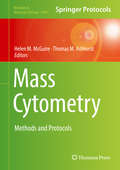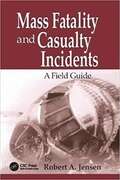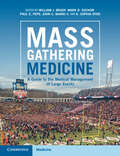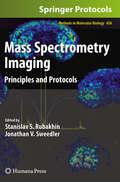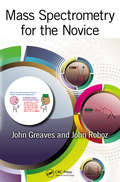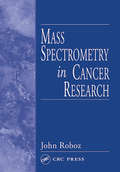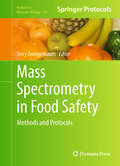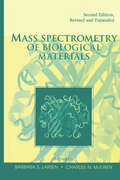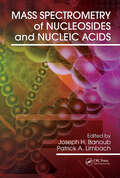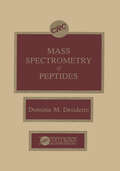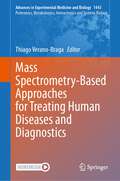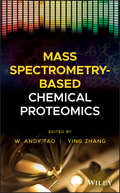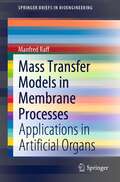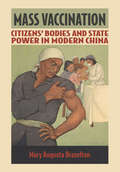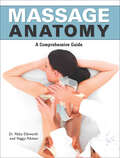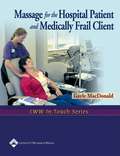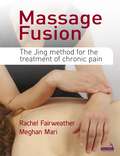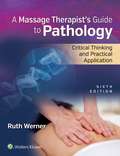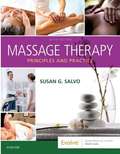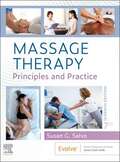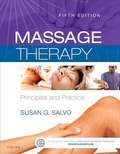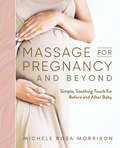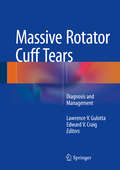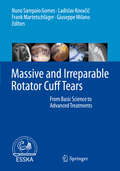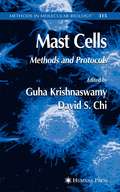- Table View
- List View
Mass Cytometry: Methods and Protocols (Methods in Molecular Biology #1989)
by Helen M. McGuire Thomas M. AshhurstThis book details up-to-date and cutting edge compilation of protocols in mass cytometry. Chapters guide readers through setting up a facility, panel design and reagent preparation, sample preparation, specific applications, and data analysis. Written in the highly successful Methods in Molecular Biology series format, chapters include introductions to their respective topics, lists of the necessary materials and reagents, step-by-step, readily reproducible laboratory protocols, and tips on troubleshooting and avoiding known pitfalls.Authoritative and cutting-edge, Mass Cytometry: Methods and Protocols aims to ensure successful results in the further study of this vital field.
Mass Fatality and Casualty Incidents: A Field Guide
by Robert A. JensenMass Fatality and Casualty Incidents: A Field Guide presents in checklist form the recommended responses to events that result in mass fatalities, such as the Oklahoma City bombing, the crash of a jet airliner, or the attack on the World Trade Center. All cities in the United States will have to have a mass fatality disaster plan in effect by the end of 1999. Mr. Jensen is a leading authority in this area and provides training for police, fire and hospital personnel (including EMTs and social workers), local, state, federal and international emergency planners and responders. This book details actions that are part of a mass fatality incident response. Specifically, they are the actions that begin once life and property preservation ceases and continues through to the release of the deceased. Thus, primary focus is on search, recovery, medicolegal investigation, personal effects operations, family assistance operations, and media operations. Ancillary steps include logistics support, security, responder protection, attitudes and coping with mass death.
Mass Gathering Medicine: A Guide to the Medical Management of Large Events
by William J. Brady Mark R. Sochor Paul E. Pepe John C. Maino II K. Sophia DyerMass medical deployments to large events, such as music festivals or sporting events, are increasing in number, size, and complexity. This textbook provides guidance and direction for rational, effective, and practical medical management of mass gathering events for medical leaders. This is the first authoritative text on mass event medicine, filling a much-needed gap in a large and important area of the specialty. An international group of contributors introduce the specialty and cover topics such as general deployment, staffing, equipment, and resources, moving on to more complex issues such as the business aspect of mass gathering medicine and the legal implications. There are also practical chapters on specific types of events and adverse events such as terrorism, severe weather, and civil disobedience. An invaluable text for all healthcare professionals planning for and attending mass events, particularly EMS professionals, large event planners and administrators, and law enforcement and security personnel.
Mass Spectrometry Imaging
by Jonathan V. Sweedler Stanislav S. RubakhinMass spectrometry (MS) offers unmatched capabilities for the detection, characterization, and identification of a broad range of analytes. Mass spectrometry imaging (MSI) integrates MS data with information on the spatial distributions of the analytes, further enhancing the applicability of MS. In Mass Spectrometry Imaging: Principles and Protocols, expert practitioners from academia, industry, and the clinic contribute cutting-edge protocols describing the application of MSI to investigations of analyte localization in a variety of specimens, from microorganisms to plant and animal tissues. Divided into three sections, this volume presents the principles of MS, current and future trends of MSI, and qualitative and quantitative protocols to measure and identify endogenous metabolites and xenobiotics. An array of MSI approaches and technologies for characterizing peptide and protein distributions are described in detail. Written in the highly successful Methods in Molecular BiologyTM series format, protocol chapters include introductions to their respective topics, lists of the necessary materials and reagents, and step-by-step, readily reproducible laboratory procedures. Also included are notes providing tips to avoid experimental pitfalls and helpful suggestions for method troubleshooting. Comprehensive and up-to-date, Mass Spectrometry Imaging: Principles and Protocols is written for scientists, biological and chemical engineers, and clinicians who are interested in applying MSI in their work and those who would benefit from having detailed experimental guidelines available in a single, convenient source.
Mass Spectrometry for the Novice
by John Greaves John RobozWith usage of mass spectrometry continually expanding, an increasing number of scientists, technicians, students, and physicians are coming into contact with this valuable technique. Mass spectrometry has many uses, both qualitative and quantitative, from analyzing simple gases to environmental contaminants, pharmaceuticals, and complex biopolymers. The extraordinary versatility can make mass spectrometers daunting to novices. Consequently, new users would benefit greatly from an understanding of the basic concepts as well as the processes that occur in these instruments. Mass Spectrometry for the Novice provides exactly that, with detailed, straightforward descriptions and clear illustrations of principles of operations and techniques.The book begins with an overview that includes essential definitions and then provides information on the components of and the strategies used in the most common instruments. The authors discuss the methodologies available, classes of compounds analyzed, and the types of data that can be generated. A group of representative applications from published articles is summarized, demonstrating the diversity of mass spectrometry. The authors also condense the essentials of the topic into one invaluable chapter that provides a set of concise take-home messages on all aspects of mass spectrometry. The final section provides a collection of resources including books, reviews, and useful websites.Using simple language, new color figures, clever cartoons, and assuming no prior knowledge, this book provides a readily understandable entrée to mass spectrometry. Downloadable resources with selected figures and cartoons is included.
Mass Spectrometry in Cancer Research
by John RobozCancer research is becoming multidisciplinary. The complex structural and therapeutic problems require synergistic approaches employing an assortment of biochemical manipulations, chromatographic or electrophoretic separations, sequencing strategies, and � more and more mass spectrometry.Mass Spectrometry in Cancer Research provides a broad
Mass Spectrometry in Food Safety
by Jerry ZweigenbaumAs a key component of human survival, a safe and sufficient food supply is essential for a healthy and productive population throughout the world, so assurance that the food supply is clean and free of harmful substances is a global concern. In Mass Spectrometry in Food Safety: Methods and Protocols, experts in the field provide context to the subject through reviews of regulations in various countries, the current state-of-the art, and specific, detailed scientific methods being employed today. The volume thoroughly covers the key areas in food safety, such as detection of low level chemical residues, pesticide analysis aided by chromatographic techniques, and the revealing of mycotoxins and chemical contaminants from packaging materials. Written in the highly successful Methods in Molecular BiologyTM series format, method chapters contain introductions to their respective topics, lists of the necessary materials and reagents, step-by-step, readily reproducible laboratory protocols, and tips on troubleshooting and avoiding known pitfalls. Pertinent and cutting-edge, Mass Spectrometry in Food Safety: Methods and Protocols serves researchers with both understanding and appreciation for the contribution of mass spectrometry and its vital application to food testing and food safety.
Mass Spectrometry of Biological Materials
by Barbara S. Larsen Charles N. McewenSecond Edition provides up-to-the-minute discussions on the application of mass spectrometry to the biological sciences. Shows how and why experiments are performed and furnishes details to facilitate duplication of results.
Mass Spectrometry of Nucleosides and Nucleic Acids
by Joseph H. Banoub Patrick A. LimbachAssembling the work of an international panel of researchers, Mass Spectrometry of Nucleosides and Nucleic Acids summarizes and reviews the latest developments in the field and provides a window on the next generation of analysis. Beginning with an overview of recent developments, the book highlights the most popular ionization methods and illustra
Mass Spectrometry of Peptides
by Dominic M. DesiderioThe purpose of this book is to collect into one volume the research done on the mass spectrometry of peptides. It balances a range of topics including theory, instrumentation, analytical techniques, and biological applications. The scope of the work contains three major sections: ionization methods, instrumental developments, and analysis of peptides. It describes 252Cf plasma desorption and laser-induced multiphoton ionization methodology. This exciting resource covers many new areas, including continuous flow FAB, quantification of human neuropeptides, and peptide mapping. It also discusses Q-FTMS, cross-links, and metal ions.
Mass Spectrometry-Based Approaches for Treating Human Diseases and Diagnostics (Advances in Experimental Medicine and Biology #1443)
by Thiago Verano-BragaThis book presents the technological advances in the field of mass spectrometry-based approaches for treating human diseases and diagnostics as well as the application of such approaches to study, in depth, human diseases, biomarkers discovery and validation, and to provide mechanistic insights of potential new therapeutics. This is an ideal book for students, technicians, researchers, and medical doctors that work in the field of mass spectrometry and proteomics
Mass Spectrometry-Based Chemical Proteomics
by W. Andy TaoPROVIDES STRATEGIES AND CONCEPTS FOR UNDERSTANDING CHEMICAL PROTEOMICS, AND ANALYZING PROTEIN FUNCTIONS, MODIFICATIONS, AND INTERACTIONS—EMPHASIZING MASS SPECTROMETRY THROUGHOUT Covering mass spectrometry for chemical proteomics, this book helps readers understand analytical strategies behind protein functions, their modifications and interactions, and applications in drug discovery. It provides a basic overview and presents concepts in chemical proteomics through three angles: Strategies, Technical Advances, and Applications. Chapters cover those many technical advances and applications in drug discovery, from target identification to validation and potential treatments. The first section of Mass Spectrometry-Based Chemical Proteomics starts by reviewing basic methods and recent advances in mass spectrometry for proteomics, including shotgun proteomics, quantitative proteomics, and data analyses. The next section covers a variety of techniques and strategies coupling chemical probes to MS-based proteomics to provide functional insights into the proteome. In the last section, it focuses on using chemical strategies to study protein post-translational modifications and high-order structures. Summarizes chemical proteomics, up-to-date concepts, analysis, and target validation Covers fundamentals and strategies, including the profiling of enzyme activities and protein-drug interactions Explains technical advances in the field and describes on shotgun proteomics, quantitative proteomics, and corresponding methods of software and database usage for proteomics Includes a wide variety of applications in drug discovery, from kinase inhibitors and intracellular drug targets to the chemoproteomics analysis of natural products Addresses an important tool in small molecule drug discovery, appealing to both academia and the pharmaceutical industry Mass Spectrometry-Based Chemical Proteomics is an excellent source of information for readers in both academia and industry in a variety of fields, including pharmaceutical sciences, drug discovery, molecular biology, bioinformatics, and analytical sciences.
Mass Transfer Models in Membrane Processes: Applications in Artificial Organs (SpringerBriefs in Bioengineering)
by Manfred RaffThis book serves as an introduction on mass transfer models in membrane processes, with a special focus on their applications in Artificial Organs. Various such models are discussed while multiple easy to use module equations are presented, enabling readers to gain basic knowledge of the mass flow of toxins across membranes. This is particularly interesting to membrane manufacturers who may use these equations to improve the relation of module performances and production costs. Additionally, examples which specialize on artificial organs, but in principle can be applied to analogous environmental, food and biotechnology processes- are analysed. This book will appeal to readers who want to understand how membrane modules and processes can be optimized and will be a great tool for graduates, researchers and professionals working in this field.
Mass Vaccination: Citizens' Bodies and State Power in Modern China (Studies of the Weatherhead East Asian Institute, Columbia University)
by Mary Augusta BrazeltonWhile the eradication of smallpox has long been documented, not many know the Chinese roots of this historic achievement. In this revelatory study, Mary Augusta Brazelton examines the PRC's public health campaigns of the 1950s to explain just how China managed to inoculate almost six hundred million people against this and other deadly diseases.Mass Vaccination tells the story of the people, materials, and systems that built these campaigns, exposing how, by improving the nation's health, the Chinese Communist Party quickly asserted itself in the daily lives of all citizens. This crusade had deep roots in the Republic of China during the Second Sino-Japanese War, when researchers in China's southwest struggled to immunize as many people as possible, both in urban and rural areas. But its legacy was profound, providing a means for the state to develop new forms of control and of engagement. Brazelton considers the implications of vaccination policies for national governance, from rural health care to Cold War-era programs of medical diplomacy. By embedding Chinese medical history within international currents, she highlights how and why China became an exemplar of primary health care at a crucial moment in global health policy.
Massage Anatomy: A Comprehensive Guide (Anatomies of)
by Abigail Ellsworth Peggy AltmanMassages energize, revitalize, and renew both body and spirit, and have even been proven to restore and promote good health. But to safely practice massage, you need to understand how the body works.<P><P> Everyone from new students to experienced massage therapists can benefit from this unique book dedicated to the practice of massage. The world of massage at your fingertips! This comprehensive book explores seven of the world's best-known styles of massage: Swedish, Fusion, Shiatsu, Thai, River Stone, Reflexology, and Reiki. Massage Anatomy uniquely combines an understanding of the human body with different massage styles, making it an excellent resource for practitioners of all levels. Detailed anatomical illustrations and approachable text demonstrate body planes, muscle groups, and crucial areas like the nervous and lymphatic systems. There is also a helpful reference section on massage terminology and a glossary of muscles. Discover the ancient secrets practiced by Native Americans and Egyptians using warm stones that are applied to the body. Feel the "spirit life force" of reiki, a centuries-old Japanese technique used to promote peace and well-being. And find out how to combine Swedish, deep-tissue, and sports massage techniques for a fabulous massage fusion.
Massage For The Hospital Patient And Medically Frail Client
by Gayle MacdonaldThis is an essential, one-of-a-kind resource for gaining the skills and knowledge you need to provide safe, effective massage therapy to patients in acute care settings and private practice clients who are medically frail. As demand grows for massage therapy in acute care, many bodyworkers seek to broaden their ability to meet this important need. To paraphrase the author: For many touch therapists, massage is more than a job or a profession--it's a calling. With the knowledge gained from this expertly written book, you will be able to confidently provide massage therapy in the hospital, other care settings, and for clients affected by health problems. It's the ideal guide for student bodyworkers and practitioners, educators, hospital administrators, and a wide range of medical professionals.
Massage Fusion
by Rachel Fairweather Meghan MariMassage Fusion is an essential companion for any manual therapist interested in treating common pain issues. Acclaimed teachers and therapists, Rachel Fairweather and Meghan Mari offer a practical and dynamic step-by-step approach to gaining results with persistent client problems such as low back pain, neck pain, headaches, carpal tunnel syndrome, TMJ disorders, stress-related conditions and stubborn sporting injuries.The book outlines a clear and evidence-based rationale to treatment using a clinically tried and tested combination of advanced massage techniques including myofascial work, trigger point therapy, acupressure, stretching and client self-care suggestions. Named after the authors' successful UK based training company, the 'Jing method' has helped thousands of therapists build their practices. Beautifully illustrated with clear photographs of each step, this book gives massage therapists a tried and tested blueprint for approaching chronic pain conditions with confidence.Drawing on both the available evidence and several decades of clinical experience, Massage Fusion brings together art and science, East and West, philosophy and psychology into a joyful exploration of how to gain the best results for your clients. A must read for all bodyworkers who want to be the best!
Massage Therapist's Guide to Pathology: Critical Thinking and Practical Application
by Ruth WernerHelp your students build strong clinical reasoning and clinical thinking skills with the new edition of Ruth Werner,,s bestselling pathology text for massage therapist students, also available as an enhanced interactive eBook. A Massage Therapist,,s Guide to Pathology, 6e continues to set the standard for the course through up-to-date, high-value content, an outstanding illustration program, and the author,,s trademark accessible writing style. With skill and passion, Werner makes pathology fascinating and understandable for massage therapy students as it prepares them to work independently or within a health care team to make choices that result in the best possible outcomes for clients living with a wide range of diseases and disorders. Updated throughout to reflect the latest research, the Sixth Edition now offers a stronger focus on evidence-informed practice. And, to keep pace with evolving standards, the Sixth Edition is now ELAP-compliant, has testing formats compatible with the MBLEx exam, and features updated content consistent with the DSM-V. For prior users, a detailed chapter-by-chapter conversion guide is available to ease transition from the Fifth to the Sixth Edition. Student Resources for each chapter: - Engaging crossword puzzles, hangman-style games, and game show questions help build familiarity with important ideas. - Flashcards reinforce concepts of the "In Brief" feature and a second set of flashcards reviews Greek/Latin roots and their English equivalents. - Practice quizzes help students assess their understanding and prepare for exams. - An Audio Glossary assists in pronunciation and key term mastery. - Interactive Labeling Exercises give students hands-on practice in labeling figures from the book. - Modality Recommendation Charts provide guidance on massage in different modalities for each condition. Instructor Resources, organized by condition and chapter: - Curriculum guidelines, "Secrets of Teaching Pathology" from the author, offer suggestions on customizing a pathology course to individual needs including how to choose content, how to use quizzes and examinations, examples of student projects, and more. - Expanded chapter objectives are ELAP-ready for faculty convenience. - Lecture notes in outline form can be used for teaching notes, student handouts, or both. - An image bank with all of the art from the text is available in an easily downloadable format. - PowerPoint slides with embedded images streamline lecture preparation. - The Test Bank, written in 2 levels ("receive and respond"/ "application of concepts") better reflects the MBLEx exam and is ideal for quizzes, tests, and homework assignments. All resources are keyed to chapter objectives for maximum usability.
Massage Therapy: Principles And Practice
by Susan G. SalvoMake the essential principles of massage therapy more approachable! Covering massage fundamentals, techniques, and anatomy and physiology, Massage Therapy: Principles and Practice, 6th Edition prepares you for success in class, on exams, and in practice settings. The new edition of this student friendly text includes more than 700 images, expanded information on the latest sanitation protocols, critical thinking questions at the end of each chapter, and updated pathologies which reflect what you will encounter in the field.
Massage Therapy: Principles and Practice
by Susan SalvoCovering massage fundamentals, techniques, and anatomy and physiology, Susan Salvo's Massage Therapy: Principles and Practice, 5th Edition brings a whole new meaning to the word 'comprehensive. ' This student-friendly text boasts expanded sections on neuroscience, research, and special populations. It makes the essential principles of massage therapy more approachable and prepares you for success in class, on licensing and board certification exams, and in a wide range of therapeutic practice settings. Clear, straightforward approach simplifies complex content for easier understanding. Complete anatomy and physiology section, in addition to material on techniques and foundations, gives you all the information you need in just one book. Certification Practice Exam on Evolve mimics the major certification exams in format and content, builds confidence, and helps increase pass rates. Case studies challenge you to think critically and apply your understanding to realistic scenarios, foster open-mindedness, and stimulate dialogue. Profile boxes provide an inspirational, real-world perspective on massage practice from some of the most respected authorities in massage and bodywork. Clinical Massage chapter focuses on massage in clinical settings like hospitals, nursing homes, and medical offices to broaden your career potential. Two business chapters loaded with skills to make you more marketable and better prepared for today's competitive job market.
Massage for Pregnancy and Beyond: Simple, Soothing Touch for Before and After Baby
by Michele Rosa MorrisonSoothing massage to support a mother before, during, and after birth Pregnancy is an exciting and challenging time, and expectant mothers need all the physical and emotional support they can get. A massage from a partner or loved one can be a beautiful way to offer that support. Massage for Pregnancy and Beyond is your how-to guide for safe and comforting massage techniques that can be used by anyone looking to do something helpful and healing for a mom-to-be. You'll learn the basics of effective massage therapy, including simple sequences to relieve everything from sore feet and hip tension to supporting a woman through the remarkable event that is birth. Massage for Pregnancy and Beyond features: Advice for the entire journey—Understand the changes mom's body is undergoing during each trimester of pregnancy, as well as labor and the postpartum phase. No experience required—Simple instructions ensure you can easily learn techniques to soothe, calm, and support a pregnant loved one. A closer connection—Discover the beauty of healing touch to provide comfort, safety, and bonding for mom, baby, and partners. Learn how pregnancy massage can help loved ones connect on the journey of bringing a new life into the world.
Massive Rotator Cuff Tears
by Lawrence V. Gulotta Edward V. CraigPresenting a logical, comprehensive approach to the patient with a massive rotator cuff tear, this book begins with the pathoanatomy and diagnostic work-up for this common injury, including imaging. Both non-operative and operative treatment options for massive tears follow, including arthroscopy, the use of biologics and patches, tendon transfers, and hemiarthroplasty and reverse total shoulder arthroplasty. A practical treatment algorithm for clinicians treating patients with massive rotator cuff tears is also included. Each chapter opens with pearls and pitfalls covering the main key points for quick reference. The overarching theme of this book is that patients with similar imaging findings may demonstrate very different clinical presentations, and the final treatment recommendation should be made based on their complaints and expectations. As such, it will be an excellent resource for orthopedic surgeons, sports medicine and shoulder physicians, physiatrists, physical medicine and rehab specialists, and occupational therapists.
Massive and Irreparable Rotator Cuff Tears: From Basic Science to Advanced Treatments
by Giuseppe Milano Nuno Sampaio Gomes Ladislav Kovačič Frank MartetschlägerThis book offers a truly comprehensive overview of the understanding and treatment of massive and irreparable rotator cuff tears, a painful and disabling shoulder condition that continues to pose major challenges. A thorough examination of basic science issues and evidence lays the foundation for discussion of key controversies in the field and exposition of a practical approach to treatment in which the role of both conservative and surgical management is explained. Special insights are provided into the new biological and nonoperative approaches that are becoming increasingly popular among practitioners. All potential surgical techniques are described, from partial repair and tendon transfer, to the use of dedicated implants. In addition, the value of anesthesia and regional blocks, both during surgery and in the postoperative phase, is discussed. The concluding section addresses particularly complex scenarios and offers guidance on the management of treatment complications and failures. Written by leading international shoulder experts, the book will be of value for shoulder surgeons, rehabilitators, and other health care practitioners.
Mast Cells
by Guha Krishnaswamy David S. ChiA cutting-edge collection of readily reproducible techniques for the isolation, culture, and study of activation and signaling in human mast cells. These methods take advantage of the latest advances in molecular biology, technology, and information science. They include methods for the identification of mast cells, the development of mast cells in vitro, the study of mast cell signaling and gene expression, and the measurement of mast cell expression of inflammatory mediators. Additional chapters cover methods for studying mast cell interactions with other cell types (endothelial cells, fibroblasts, and B cells), the roles of mast cells in host defense, and mast cell apoptosis.
